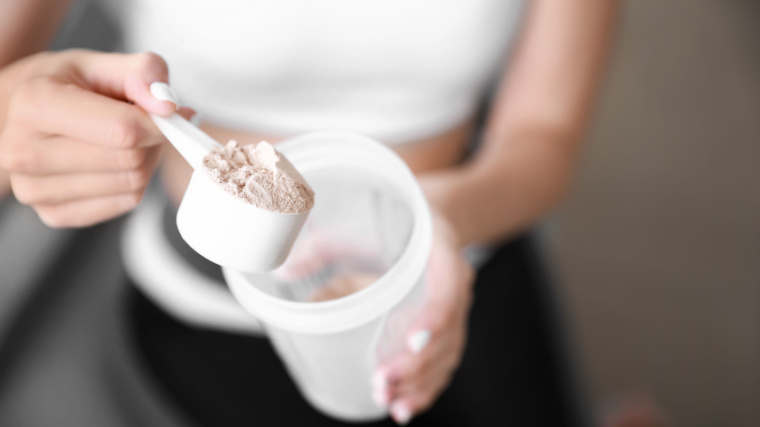Creatine has a bit of a public relations problem. Non-lifters and overprotective parents sometimes think it’s a steroid. Airport security usually thinks it’s something even more illicit. But dedicated lifters know that creatine is quite possibly the holy grail of supplements, being both highly effective and well-researched.

Creatine is so popular among gym-goers because it’s one of the few supplements with seemingly endless science behind it. It’s arguably the most proven and data-supported supplement out there, especially when it comes to supporting strength and hypertrophy gains. So it can help you lift heavier and pack on muscle. Who could ask for more? Here’s a closer look at how to use creatine to maximize those tantalizing results.
Creatine Monohydrate
What is Creatine and How Does It Help?
In recent decades, creatine has gained considerable popularity as a dietary supplement among athletes and fitness enthusiasts. (1)(2)(3)
Creatine is a naturally occurring compound found in the body, and it’s also found, in relatively small amounts, in everyday foods like beef, chicken, and eggs. The benefits of creatine supplementation have been extensively studied over the years. Caution: There’s some scientific discussion ahead, but it’ll all make sense by the end.
Creatine is synthesized from the amino acids glycine and arginine in the liver, pancreas, and kidneys. Once synthesized or consumed, creatine is primarily stored in your muscles as phosphocreatine (PCr).
One of the fundamental ways creatine functions in your body is by aiding in the production of adenosine triphosphate (ATP) — the primary source of energy for cellular processes. During high-intensity exercise, such as weight lifting or sprinting, the demand for ATP increases. However, ATP stores are limited and they deplete rapidly. This is why intense exercise can only be sustained for so long.
That’s where creatine comes into play. It “donates” its high-energy phosphate group to adenosine diphosphate (ADP), converting it back into ATP through a process called phosphorylation. This replenishes the ATP stores, allowing muscles to continue contracting forcefully and perform at a higher intensity for longer periods. (4)(5)(6)(7)(8) In a nutshell, this powerhouse supplement gives you the edge needed to push harder in the gym.
Muscle Growth and Volume
Creatine also plays a vital role in promoting muscle growth and increasing muscle volume. When creatine is ingested, it leads to an increase in creatine stores within your muscles. This increased creatine availability enhances cellular hydration by drawing water into the muscle cells. Consequently, muscles appear fuller and larger, contributing to a more pronounced muscular appearance. (9)(10)(11)(12)(13)

This is why you’ll likely see the scale go up a little bit within your first few weeks of taking creatine. You are “retaining water,” but in a good way. The water is enlarging your muscle cells, not your love handles like after a salty Chinese buffet.
Furthermore, creatine supplementation has been shown to stimulate protein synthesis — the process by which new muscle tissue is built. It also reduces muscle protein breakdown, aiding in the preservation of existing muscle mass. This dual action of promoting muscle protein synthesis and inhibiting protein breakdown creates an anabolic environment that supports muscle growth and development.
Improved Exercise Performance
Creatine has consistently demonstrated its ability to enhance exercise performance across a wide range of activities. By increasing the availability of ATP, creatine supplementation allows for improved strength, power, and endurance during high-intensity, short-duration activities.
Athletes engaged in activities such as lifting weights, running, and jumping may benefit from creatine supplementation due to its potential to increase performance in explosive movements.
Additionally, creatine has shown positive effects on repeated bouts of high-intensity exercise with short recovery periods, like interval workouts or circuit training. Creatine helps to replenish ATP stores more rapidly, reducing fatigue and enabling athletes to maintain their performance during successive bouts of intense exercise.
Neuroprotective Effects
Beyond its benefits for physical performance, this “meathead” supplement is also good for your brain. Creatine is actively transported into the brain, where it acts as an energy buffer, providing neurons with a readily available source of ATP. (14) This energy support may help protect brain cells against damage and improve overall brain function. (15)(16)
Furthermore, studies have indicated that creatine supplementation might have potential therapeutic applications for neurodegenerative conditions such as Parkinson’s disease, Alzheimer’s disease, and Huntington’s disease. (17) While more research is needed in this area, the neuroprotective properties of creatine are promising and warrant further exploration.
Some research has also indicated that low creatine levels may correlate with higher rates of depression and anxiety, especially in vegetarian/vegan populations which are typically lacking in creatine from food sources. (18)
How to Take Creatine
When it comes to selecting a creatine supplement, there are several options available. The most common and well-researched form is creatine monohydrate. It’s the most cost-efficient, highly effective, widely used, and most thoroughly researched form of creatine.
In fact, creatine monohydrate has the ability to fully saturate your muscles. More expensive forms of creatine — creatine hcl, creatine ethyl ester, etc. — can range from being “as good as monohydrate” to simply worse, despite promising to saturate your muscles more than monohydrate. This claim is just not possible. Creatine monohydrate already fully saturates your muscles efficiently. There’s not a “more efficient” form available.
While creatine monohydrate is still a relatively inexpensive supplement, its price has increased in recent years due to popularity. Your best bet is to buy it in bulk when possible and avoid proprietary blends — pure micronized creatine monohydrate is all you need. That’s the form that is most commonly studied in research.
Loading Phase vs. Maintenance Phase
To quickly saturate your muscles with creatine, a “loading phase” is often recommended. During this five to seven-day period, take 20 grams of creatine monohydrate per day, divided into four equal doses of five grams each. This loading phase allows your muscles to reach maximum creatine levels and deliver optimal results more rapidly.

After the loading phase, switch to a maintenance dosage of three to five grams per day. It’s essential to note that creatine has been shown to be safe for long-term use, so there is no need to “cycle” on and off by stopping use of the supplement for several weeks (or months) at a time. (19)
Keep in mind that you can simply start with a maintenance phase to get your muscles fully saturated within three to four weeks and still end up with the same net benefits. This option is better for those who might potentially experience GI distress from the relatively high daily dosing involved with creatine loading.
Hydration and Timing
Creatine works best when the body is adequately hydrated. Therefore, it’s crucial to drink plenty of water throughout the day, every day, when supplementing with creatine. Aim to consume at least 8-10 glasses of water daily — at least 64 ounces per day — and always take it with water. No “dry scooping” like your favorite fitfluencer slamming a pre-workout.
Timing is also an important consideration. While creatine can be taken at any time during the day, consuming it post-workout may provide additional benefits. Most research finds this to be the optimal time because your muscles are highly sensitive to insulin, allowing them to absorb more nutrients and water. This is why it’s ideal to take creatine with your post workout meal. (20)
If you prefer to take it at another point in the day for convenience, that is fine too. Consistency to keep your muscles fully saturated is most important, which leads to the next point: If you exercise regularly, be sure to take creatine daily even on your rest days. There are still non-exercise related benefits to taking creatine, including brain health and cognitive function as explained earlier.
Potential Side Effects
As with any supplement, it’s essential to monitor your progress and be aware of any potential side effects. The most common side effect of creatine supplementation may include mild gastrointestinal distress. However, this side effect is typically minimal and temporary. Reducing the daily dose often resolves the issue.
If you do notice GI distress: don’t do a loading phase, be sure you’re taking micronized creatine (which dissolves more thoroughly and may digest easier), and take creatine with a meal. Overall though, GI distress is relatively rare.
Some people claim water retention as another side effect, but this is actually a good thing. It shows that creatine is working and being absorbed into your muscle stores. The scale going up when initially taking creatine is affirming, especially if you’re already carrying a degree of muscle mass.
The more muscled you are, the more water your body should absorb. If you are not gaining any weight after beginning creatine use, it’s likely not as detectable or you simply don’t yet have significant muscle mass to benefit from the muscle-related benefits.
Lastly, hair loss is another commonly touted side effect, but this is more fear-mongering than reality. In the decades of creatine research, there has only been one study on this — rugby players taking creatine experienced higher levels of DHT, an androgen that potentially increases hair loss. (21)

However, it’s understandable that this androgen is higher to explain the benefits of creatine. Intense exercise, itself, can increase DHT levels. Not to mention, the high-level rugby players in the study could have potentially been taking additional supplements, or performance enhancing substances, which could provide a more significant underlying cause.
There has never been research showing creatine directly impacting hair loss. Anecdotally, I’ve never encountered this either even after working with hundreds of male clients taking creatine.
Research generally finds creatine has a great safety profile. (22) If you have any underlying medical conditions, it’s crucial to consult with your healthcare provider before starting creatine supplementation (or any supplementation, for that matter). They can provide personalized advice based on your potential individual circumstances.
That being said, creatine supplementation will raise creatinine levels in your bloodwork, which might worry your doctor a bit if they don’t lift and aren’t aware that elevated creatinine levels are not, on their own, an indicator worth ringing any alarm bells. (22) All your other metrics should be relatively unchanged though.
Creatine – Simply the Best for Body and Mind
Creatine is a remarkable compound with myriad benefits. By enhancing ATP production, promoting muscle growth, and improving exercise performance, creatine has become one of the most widely-used supplement in the sports and fitness communities. Its potential neuroprotective properties further contribute to its growing significance in scientific research. However, it is crucial to approach creatine supplementation responsibly, adhering to recommended dosages and seeking professional guidance when necessary. But outside of rare exceptions, most people can and should plan on taking it until they join the big gym in the sky, so put a permanent spot for creatine monohydrate in your budget.
References
- Baker, J. S., McCormick, M. C., & Robergs, R. A. (2010). Interaction among Skeletal Muscle Metabolic Energy Systems during Intense Exercise. Journal of nutrition and metabolism, 2010, 905612. https://doi.org/10.1155/2010/905612
- Cholewa, J., Trexler, E., Lima-Soares, F., de Araújo Pessôa, K., Sousa-Silva, R., Santos, A. M., Zhi, X., Nicastro, H., Cabido, C. E. T., de Freitas, M. C., Rossi, F., & Zanchi, N. E. (2019). Effects of dietary sports supplements on metabolite accumulation, vasodilation and cellular swelling in relation to muscle hypertrophy: A focus on “secondary” physiological determinants. Nutrition (Burbank, Los Angeles County, Calif.), 60, 241–251. https://doi.org/10.1016/j.nut.2018.10.011
- Kaviani M, Shaw K, Chilibeck PD. Benefits of Creatine Supplementation for Vegetarians Compared to Omnivorous Athletes: A Systematic Review. International Journal of Environmental Research and Public Health. 2020; 17(9):3041. https://doi.org/10.3390/ijerph17093041
- Branch J. D. (2003). Effect of creatine supplementation on body composition and performance: a meta-analysis. International journal of sport nutrition and exercise metabolism, 13(2), 198–226. https://doi.org/10.1123/ijsnem.13.2.198
- Chilibeck, P. D., Kaviani, M., Candow, D. G., & Zello, G. A. (2017). Effect of creatine supplementation during resistance training on lean tissue mass and muscular strength in older adults: a meta-analysis. Open access journal of sports medicine, 8, 213–226. https://doi.org/10.2147/OAJSM.S123529
- Engelhardt, M., Neumann, G., Berbalk, A., & Reuter, I. (1998). Creatine supplementation in endurance sports. Medicine and science in sports and exercise, 30(7), 1123–1129. https://doi.org/10.1097/00005768-199807000-00016
- Cooper, R., Naclerio, F., Allgrove, J. et al. Creatine supplementation with specific view to exercise/sports performance: an update. J Int Soc Sports Nutr 9, 33 (2012). https://doi.org/10.1186/1550-2783-9-33
- Stares, A., & Bains, M. (2020). The Additive Effects of Creatine Supplementation and Exercise Training in an Aging Population: A Systematic Review of Randomized Controlled Trials. Journal of geriatric physical therapy (2001), 43(2), 99–112. https://doi.org/10.1519/JPT.0000000000000222
- Chilibeck, P. D., Kaviani, M., Candow, D. G., & Zello, G. A. (2017). Effect of creatine supplementation during resistance training on lean tissue mass and muscular strength in older adults: a meta-analysis. Open access journal of sports medicine, 8, 213–226. https://doi.org/10.2147/OAJSM.S123529
- Farshidfar, F., Pinder, M. A., & Myrie, S. B. (2017). Creatine Supplementation and Skeletal Muscle Metabolism for Building Muscle Mass- Review of the Potential Mechanisms of Action. Current protein & peptide science, 18(12), 1273–1287. https://doi.org/10.2174/1389203718666170606105108
- Burke, D. G., Candow, D. G., Chilibeck, P. D., MacNeil, L. G., Roy, B. D., Tarnopolsky, M. A., & Ziegenfuss, T. (2008). Effect of creatine supplementation and resistance-exercise training on muscle insulin-like growth factor in young adults. International journal of sport nutrition and exercise metabolism, 18(4), 389–398. https://doi.org/10.1123/ijsnem.18.4.389
- Willoughby, D. S., & Rosene, J. M. (2003). Effects of oral creatine and resistance training on myogenic regulatory factor expression. Medicine and science in sports and exercise, 35(6), 923–929. https://doi.org/10.1249/01.MSS.0000069746.05241.F0
- Saremi, A., Gharakhanloo, R., Sharghi, S., Gharaati, M. R., Larijani, B., & Omidfar, K. (2010). Effects of oral creatine and resistance training on serum myostatin and GASP-1. Molecular and cellular endocrinology, 317(1-2), 25–30. https://doi.org/10.1016/j.mce.2009.12.019
- Avgerinos, K. I., Spyrou, N., Bougioukas, K. I., & Kapogiannis, D. (2018). Effects of creatine supplementation on cognitive function of healthy individuals: A systematic review of randomized controlled trials. Experimental gerontology, 108, 166–173. https://doi.org/10.1016/j.exger.2018.04.013
- Dolan, E., Gualano, B., & Rawson, E. S. (2019). Beyond muscle: the effects of creatine supplementation on brain creatine, cognitive processing, and traumatic brain injury. European journal of sport science, 19(1), 1–14. https://doi.org/10.1080/17461391.2018.1500644
- RAWSON, ERIC S.1; VOLEK, JEFF S.2. Effects of Creatine Supplementation and Resistance Training on Muscle Strength and Weightlifting Performance. Journal of Strength and Conditioning Research 17(4):p 822-831, November 2003.
- Bakian, A.V., Huber, R.S., Scholl, L. et al. Dietary creatine intake and depression risk among U.S. adults. Transl Psychiatry 10, 52 (2020). https://doi.org/10.1038/s41398-020-0741-x
- Bender, A., Klopstock, T. Creatine for neuroprotection in neurodegenerative disease: end of story?. Amino Acids 48, 1929–1940 (2016). https://doi.org/10.1007/s00726-015-2165-0
- Kreider, R. B., Melton, C., Rasmussen, C. J., Greenwood, M., Lancaster, S., Cantler, E. C., Milnor, P., & Almada, A. L. (2003). Long-term creatine supplementation does not significantly affect clinical markers of health in athletes. Molecular and cellular biochemistry, 244(1-2), 95–104.
- Antonio, J., & Ciccone, V. (2013). The effects of pre versus post workout supplementation of creatine monohydrate on body composition and strength. Journal of the International Society of Sports Nutrition, 10, 36. https://doi.org/10.1186/1550-2783-10-36
- van der Merwe, J., Brooks, N. E., & Myburgh, K. H. (2009). Three weeks of creatine monohydrate supplementation affects dihydrotestosterone to testosterone ratio in college-aged rugby players. Clinical journal of sport medicine : official journal of the Canadian Academy of Sport Medicine, 19(5), 399–404. https://doi.org/10.1097/JSM.0b013e3181b8b52f
- Kim HJ, Kim CK, Carpentier A, Poortmans JR. Studies on the safety of creatine supplementation. Amino Acids. 2011 May;40(5):1409-18. doi: 10.1007/s00726-011-0878-2. Epub 2011 Mar 12. PMID: 21399917.
Featured Image: RHJPhtotos / Shutterstock
Trending Products

FITINDEX Vibrating Foam Roller 5-Speed, Next Generation Electric Foam Roller for Muscle Relax, Fitness Deep Massage Foam…

Resistance Bands for Working Out with Exercise Guide. Fabric Booty Bands for Women Men. Workout Bands Leg Bands for…

GAODI Women Waist Trainer Vest Workout Slim Corset Neoprene Sauna Tank Top Zipper Weight Loss Body Shaper

FITNE Green Tea Herbal Honey Lemon With Garcinia Senna Infusion Gentle Detox Cleanse High Antioxidant No Calories Stevia…

Sunny Health & Fitness Squat Assist Row-N-Ride™ Trainer for Glutes Workout

FITNE Black Currant Herbal Green Tea Fruity Garcinia Senna Infusion Gentle Detox Cleansing Boost Antioxidant Wellness…

Cork Squat Wedge Block 2PCS Non Slip Professional Squat Ramp,Squat Platform for Heel Elevated Squats and Calf Raises…








